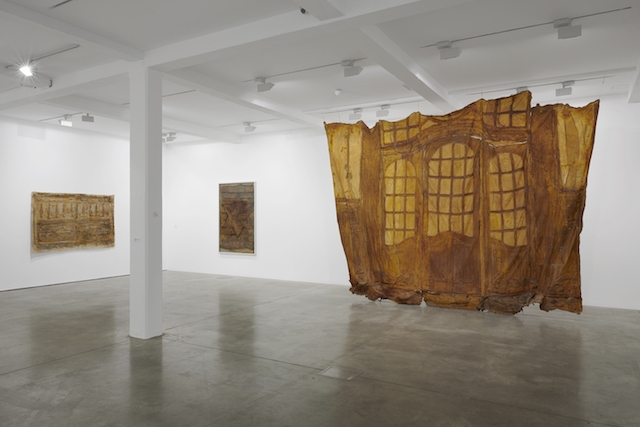Heidi Bucher flays a building. In a short filmwork near the entrance to this retrospective she pulls and tugs at the skin of dried latex – previously applied, dripping wet, by her own hands – that has formed over the walls, windows and doors of a Swiss psychiatric hospital. The layer of material she peels away reveals one side of Kleines Glasportal, Bellevue Kreuzlingen (1988), stuck with the dust and dirt of the surfaces that shaped the latex mould. Imprinted with the outline of an ornate glass doorframe, the sheet, hung from the ceiling in the middle of the gallery by nine thin wires, is surrounded by other Häutungen, or skinnings, as the late Swiss artist liked to call them. There is Borg (1976), the epidermis of a doorway propped up by bamboo sticks and covered with the sheen of mother-of-pearl powder (a material that recurs in Bucher’s work), and the latex and gauze shedding of shutters and shingles of Fenster mit Läden und Schindeln (1988).
Bucher’s Häutungen are a disruption of architectural space, a manifestation of the liminal – that which is caught in between, neither here-now nor there-then. ‘The door is an entire cosmos of the Half-open’, wrote French philosopher Gaston Bachelard in the penultimate chapter of ThePoetics of Space (1958), and this idea of the half-open, or the half-visible, the inside and outside, works in equilibrium with the material appeal of the works on show. To be offered the traces of things, rather than the objects themselves, as in Bucher’s 1979 Frottage series, in which she creates graphite rubbings on paper of various garments, is to deny their definition, or function, and instead allow room for what Bachelard calls the ‘escapades of imagination’.
As much is demonstrated by another film, Hautraum (1981), in which a flimsy cubic structure of latex walls – a ‘skinroom’ – is dangled from a swinging crane and flown through the air, flapping around unsteadily like half a box kite. The fragility of the Hautraum echoes in the four Weissleimhaus (1976–83) – small ‘glue houses’ made with foam, textile and gauze – each placed on its own pedestal and protected by an acrylic display case: they are ghostly objects, the thickness of glue lending to the houses both opaque and semitransparent qualities, each with four walls, one door, no roof (can something be a house when it cannot provide shelter?).
Bucher’s works play in the spaces between what is geometrically considered the ‘outside’ and ‘inside’, which is to say that while they prevent viewers from positioning themselves in relation to the work and its subject, they also invite familiarity through the imprint of everyday objects and architectural elements, and the tactile qualities of these. As Bucher pulls free the membranes of buildings, she both exposes and preserves the memories of her subjects while exfoliating them of time, place and thinghood. Here, the skin is the half-open, the portal through which we feel ourselves in the world.
Heidi Bucher at Parasol Unit, London, 19 September – 9 December
From the January & February 2019 issue of ArtReview
